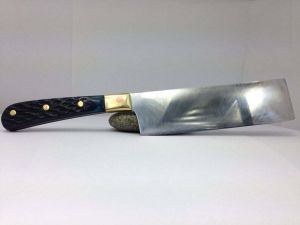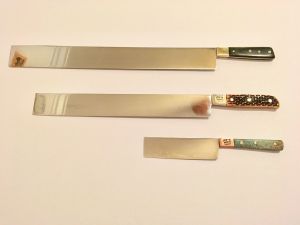The Shechitah Knife: Difference between revisions
From Halachipedia
MordechaiD (talk | contribs) |
MordechaiD (talk | contribs) |
||
| Line 13: | Line 13: | ||
===Glowing Hot Knife=== | ===Glowing Hot Knife=== | ||
# A knife that is heated till it glows (incandescent) may not be used, as the heat from the sides of the blade burns the simanim before the blade finishes severing them, resulting in a piercing instead of a shechitah. The meat would be prohibited on a Torah level. Some are lenient bediavad if the shochet was aware and maneuvered the knife in a way that avoids the sides touching the simanim, but the halacha follows the strict view. Some say the minimum temperature of the metal is Yad Soledet Bo.<ref>Simla Chadasha 9:1</ref> | # A knife that is heated till it glows (incandescent) may not be used, as the heat from the sides of the blade burns the simanim before the blade finishes severing them, resulting in a piercing instead of a shechitah. The meat would be prohibited on a Torah level. Some are lenient bediavad if the shochet was aware and maneuvered the knife in a way that avoids the sides touching the simanim, but the halacha follows the strict view. Some say the minimum temperature of the metal is Yad Soledet Bo.<ref>Simla Chadasha 9:1</ref> | ||
===Non-Kosher Knives=== | |||
===Knives Used for Idolatry=== | |||
# One may not benefit from tools used to worship an idol, therefore, the knife used to slaughter animals for idolatrous sacrifices is prohibited from benefit. That said, killing a healthy animal is arguably more detrimental than it is beneficial, as the animal is no longer alive to grow or work. A dead animal is only good for its meat and entails a necessary loss. Similar arguments could be made for birds. As such, shechting a healthy animal or bird with a knife used for idolatrous activities is permissible, because causing a loss is not considered benefit. However, a sick animal may not be shechted with that knife, as that would be considered an improvement. Some argue the same is true for a very violent or high maintenance animal that comes at a loss to its owner or if the price of meat is higher than the price of the animal it comes from.<ref>Simla Chadasha 10:1</ref> | |||
# If the knife was used to cut wood which was then used for idolatry, then it's permissible. It's only considered a knife of Meshamshei Avodah Zarah when the idol is finished with the knife or sacrifices are slaughtered with it.<ref>Simla Chadasha 10:2</ref> | |||
# A sick animal slaughtered with a knife of Meshamshei Avodah Zarah is entirely prohibited from benefit until one throws away enough meat the value of which is equal to the cost of shechting with it. If there aren't any more knives avaialble, then the cost of shechting must go up.<ref>Simla Chadasha 10:3</ref> | |||
==Crafting a Shechitah Knife== | ==Crafting a Shechitah Knife== | ||
Modern day shechitah knives are commonly rectangularly shaped to facilitate shechitah without issues of chaladah and derasa and made with easy to sharpen steel that maintains its edge to minimize pegimot. | Modern day shechitah knives are commonly rectangularly shaped to facilitate shechitah without issues of chaladah and derasa and made with easy to sharpen steel that maintains its edge to minimize pegimot. | ||
Revision as of 19:43, 20 July 2023
What Can Be Used for Shechitah
- Technically, anything that is detached from the ground and sharp can be used for kosher slaughter, as long as it's free of imperfections. A reed membrane would be good if it doesn't have any splinters that would come out. Practically, however, this is exclusively done with a knife.[1]
- One shouldn't use a scythe or even a double edged knife if one side of it is a scythe. Bediavad if he did it and knows he used the kosher side, it's ok, and if he smoothened out the scythe side then he can use it lechatechilah.[2]
Detached From Its Source
- Anything sharp attached to the ground or a body may not be used for shechitah until it is detached.[3]
- If it was detached and then reattached, one still should not use it regardless of whether he plans to leave it there (which would render the meat prohibited due to the Gemara's uncertainty) or not (which would be invalid on a rabbinic level). If one's intention is unformulated, we can determine based on context.[4]
- An animal's jaw with sharp teeth may not be used, as the gaps between teeth are the same as nicks in a knife, but a singly tooth attached to a jaw is fine. Even a single nail on a severed foot would be ok. Some argue that if it's still attached to a whole limb, such as a whole jaw or whole animal foot, that would be considered "attached" to its source of growth.[5]
Pegimot
- A knife with a pegima (nick) may not be used. Bediavad, if one used it and claims he didn't use that part of the blade, the meat is kosher, but if he didn't realize it was there until afterwards, he has no claim.[6]
- Ideally even if one covers the pegimah, he might accidentally use the part with the pegimah.[7]
- If the blade has two edges, one must make sure both are free of pegimot.[8]
- On Yom Tov or in pressing circumstances, one can cover the pegima and shecht carefully, avoiding the pegimah, as long as there are two neck widths of length left of the knife from the pegimah in either direction and one shechts in a sawing motion. Some say the length is measured from the end of the cloth and not the pegimah. All this applies for two pegimot with enough blade length in between, as well.[9]
Glowing Hot Knife
- A knife that is heated till it glows (incandescent) may not be used, as the heat from the sides of the blade burns the simanim before the blade finishes severing them, resulting in a piercing instead of a shechitah. The meat would be prohibited on a Torah level. Some are lenient bediavad if the shochet was aware and maneuvered the knife in a way that avoids the sides touching the simanim, but the halacha follows the strict view. Some say the minimum temperature of the metal is Yad Soledet Bo.[10]
Non-Kosher Knives
Knives Used for Idolatry
- One may not benefit from tools used to worship an idol, therefore, the knife used to slaughter animals for idolatrous sacrifices is prohibited from benefit. That said, killing a healthy animal is arguably more detrimental than it is beneficial, as the animal is no longer alive to grow or work. A dead animal is only good for its meat and entails a necessary loss. Similar arguments could be made for birds. As such, shechting a healthy animal or bird with a knife used for idolatrous activities is permissible, because causing a loss is not considered benefit. However, a sick animal may not be shechted with that knife, as that would be considered an improvement. Some argue the same is true for a very violent or high maintenance animal that comes at a loss to its owner or if the price of meat is higher than the price of the animal it comes from.[11]
- If the knife was used to cut wood which was then used for idolatry, then it's permissible. It's only considered a knife of Meshamshei Avodah Zarah when the idol is finished with the knife or sacrifices are slaughtered with it.[12]
- A sick animal slaughtered with a knife of Meshamshei Avodah Zarah is entirely prohibited from benefit until one throws away enough meat the value of which is equal to the cost of shechting with it. If there aren't any more knives avaialble, then the cost of shechting must go up.[13]
Crafting a Shechitah Knife
Modern day shechitah knives are commonly rectangularly shaped to facilitate shechitah without issues of chaladah and derasa and made with easy to sharpen steel that maintains its edge to minimize pegimot.
- One should use a knife that ends in a right angle, not a sharp point, in order to avoid chaladah. In pressing circumstances, can can cover the tip with something light and then shecht (a hard tip cover could lead to derasa).[14]
- Some say the top of the knife should also be void of pegimot,[15] in case one ends up cutting with the top, while others note how the rectangular knives we use today avoid this issue.[16]
- The ideal shechitah knife is twice as long as the neck of the target category;[17] therefore, bird (ofos) knives are usually about five inches long, sheep (dakos) knives are usually nine inches long, and cattle (gasos) knives are usually about sixteen inches long.[18]
- The instrument used to shecht should preferably be as smooth as possible on both sides. Therefore, although engravings in the blade far from the edge do not render the shechitah invalid, but one should ideally use a knife free of any engravings. Anything sticking out of the side would be a problem even bediavad despite being far from the edge.[19]
Sharpening a Shechitah Knife
Sharpening a knife is done by grinding the edge against coarse and then fine whetstones, back and forth, one side and then the other, until the knife is sharp and smooth.
Checking a Shechitah Knife
Guides
- Esek Hashechita by Rabbi Dovid Shaffier. See SeforimChatter Review here. (Book)
- Laevi Sussman's Video Guide (Video)
- IBC Experiential Halacha: Basics of Shechita-Knife Sharpening (Audio)
- Guide to Sharpening a Shechita Knife by Rabbi Avraham Moshe (PDF)
Purchasing a Knife
Sources
- ↑ Simla Chadasha 6:1
- ↑ Simla Chadasha 6:2
- ↑ Simla Chadasha 6:5
- ↑ Simla Chadasha 6:5
- ↑ Simla Chadasha 6:6
- ↑ Simla Chadasha 6:3
- ↑ Simla Chadasha 6:3
- ↑ Simla Chadasha 6:3
- ↑ Simla Chadasha 6:3
- ↑ Simla Chadasha 9:1
- ↑ Simla Chadasha 10:1
- ↑ Simla Chadasha 10:2
- ↑ Simla Chadasha 10:3
- ↑ Simla Chadasha 6:4
- ↑ Simla Chadasha 6:4
- ↑ Mateh Asher 6:5
- ↑ See Simla Chadasha 8:2 and [The Shechitah Process] for more details.
- ↑ See IBC Experiential Halacha: Chicken Shechita
- ↑ Simla Chadasha 9:2

